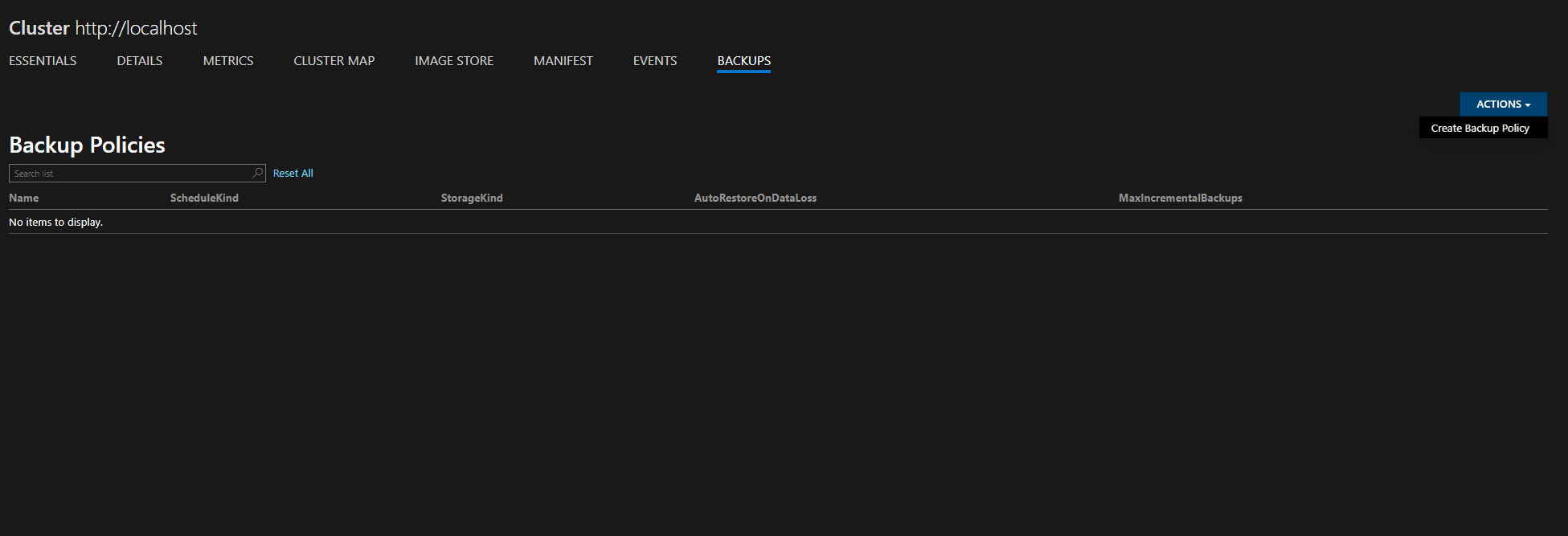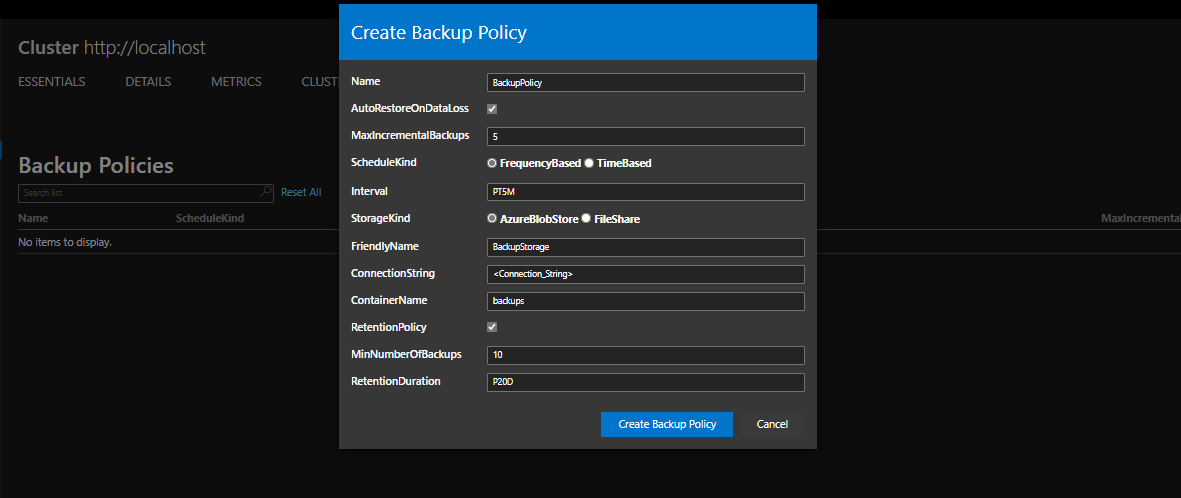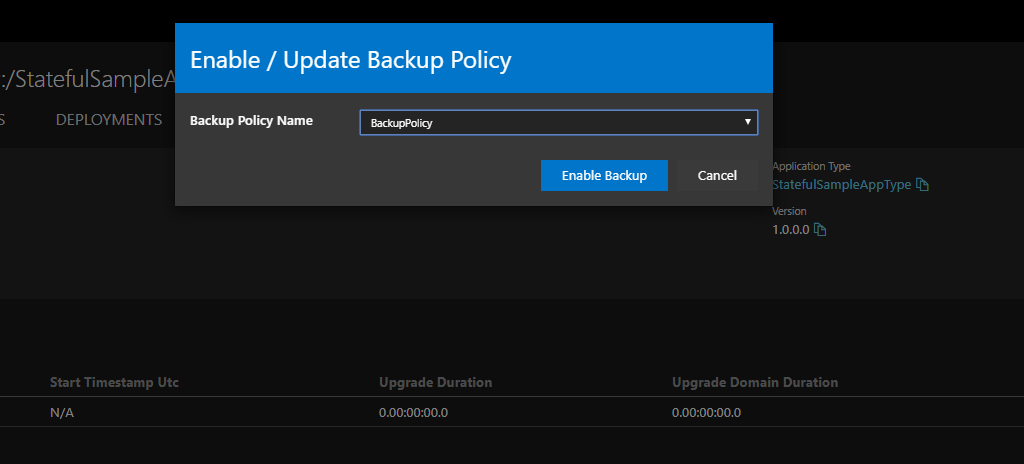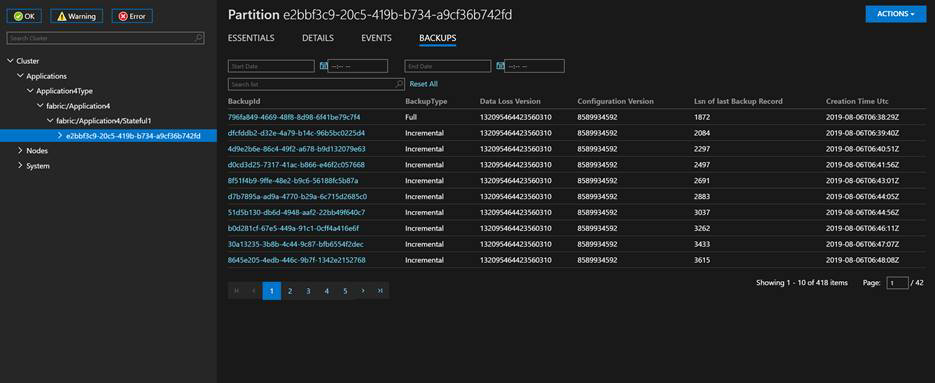Periodic backup and restore in an Azure Service Fabric cluster
Service Fabric is a distributed systems platform that makes it easy to develop and manage reliable, distributed, microservices based cloud applications. It allows running of both stateless and stateful micro services. Stateful services can maintain mutable, authoritative state beyond the request and response or a complete transaction. If a Stateful service goes down for a long time or loses information due to a disaster, it may need to be restored to some recent backup of its state in order to continue providing service after it comes back up.
Service Fabric replicates the state across multiple nodes to ensure that the service is highly available. Even if one node in the cluster fails, the service continues to be available. In certain cases, however, it is still desirable for the service data to be reliable against broader failures.
For example, service may want to back up its data in order to protect from the following scenarios:
- In the event of the permanent loss of an entire Service Fabric cluster.
- Permanent loss of a majority of the replicas of a service partition
- Administrative errors whereby the state accidentally gets deleted or corrupted. For example, an administrator with sufficient privilege erroneously deletes the service.
- Bugs in the service that cause data corruption. For example, this may happen when a service code upgrade starts writing faulty data to a Reliable Collection. In such a case, both the code and the data may have to be reverted to an earlier state.
- Offline data processing. It might be convenient to have offline processing of data for business intelligence that happens separately from the service that generates the data.
Service Fabric provides an inbuilt API to do point in time backup and restore. Application developers may use these APIs to back up the state of the service periodically. Additionally, if service administrators want to trigger a backup from outside of the service at a specific time, like before upgrading the application, developers need to expose backup (and restore) as an API from the service. Maintaining the backups is an additional cost above this. For example, you may want to take five incremental backups every half hour, followed by a full backup. After the full backup, you can delete the prior incremental backups. This approach requires additional code leading to additional cost during application development.
The Backup and Restore service in Service Fabric enables easy and automatic backup of information stored in stateful services. Backing up application data on a periodic basis is fundamental for guarding against data loss and service unavailability. Service Fabric provides an optional backup and restore service, which allows you to configure periodic backup of stateful Reliable Services (including Actor Services) without having to write any additional code. It also facilitates restoring previously taken backups.
Service Fabric provides a set of APIs to achieve the following functionality related to periodic backup and restore feature:
- Schedule periodic backup of Reliable Stateful services and Reliable Actors with support to upload backup to (external) storage locations. Supported storage locations
- Azure Storage
- File Share (on-premises)
- Enumerate backups
- Trigger an ad hoc backup of a partition
- Restore a partition using previous backup
- Temporarily suspend backups
- Retention management of backups (upcoming)
Prerequisites
- Service Fabric cluster with Fabric version 6.4 or above. Refer to this article for steps to create Service Fabric cluster using Azure resource template.
- X.509 Certificate for encryption of secrets needed to connect to storage to store backups. Refer article to know how to get or create an X.509 certificate.
- Service Fabric Reliable Stateful application built using Service Fabric SDK version 3.0 or above. For applications targeting .NET Core 2.0, application should be built using Service Fabric SDK version 3.1 or above.
- Create Azure Storage account for storing application backups.
- Install Microsoft.ServiceFabric.Powershell.Http Module (Preview) for making configuration calls.
Install-Module -Name Microsoft.ServiceFabric.Powershell.Http -AllowPrerelease
Note
If your PowerShellGet version is less than 1.6.0, you'll need to update to add support for the -AllowPrerelease flag:
Install-Module -Name PowerShellGet -Force
- Make sure that Cluster is connected using the
Connect-SFClustercommand before making any configuration request using Microsoft.ServiceFabric.Powershell.Http Module.
Connect-SFCluster -ConnectionEndpoint 'https://mysfcluster.southcentralus.cloudapp.azure.com:19080' -X509Credential -FindType FindByThumbprint -FindValue '1b7ebe2174649c45474a4819dafae956712c31d3' -StoreLocation 'CurrentUser' -StoreName 'My' -ServerCertThumbprint '1b7ebe2174649c45474a4819dafae956712c31d3'
Enabling backup and restore service
Using Azure portal
Enable Include backup restore service check box under + Show optional settings in Cluster Configuration tab.

Using Azure Resource Manager Template
First you need to enable the backup and restore service in your cluster. Get the template for the cluster that you want to deploy. You can either use the sample templates or create a Resource Manager template. Enable the backup and restore service with the following steps:
Check that the
apiversionis set to2018-02-01for theMicrosoft.ServiceFabric/clustersresource, and if not, update it as shown in the following snippet:{ "apiVersion": "2018-02-01", "type": "Microsoft.ServiceFabric/clusters", "name": "[parameters('clusterName')]", "location": "[parameters('clusterLocation')]", ... }Now enable the backup and restore service by adding the following
addonFeaturessection underpropertiessection as shown in the following snippet:"properties": { ... "addonFeatures": ["BackupRestoreService"], "fabricSettings": [ ... ] ... }Configure X.509 certificate for encryption of credentials. This is important to ensure that the credentials provided to connect to storage are encrypted before persisting. Configure encryption certificate by adding the following
BackupRestoreServicesection underfabricSettingssection as shown in the following snippet:"properties": { ... "addonFeatures": ["BackupRestoreService"], "fabricSettings": [{ "name": "BackupRestoreService", "parameters": [{ "name": "SecretEncryptionCertThumbprint", "value": "[Thumbprint]" },{ "name": "SecretEncryptionCertX509StoreName", "value": "My" }] } ... }Note
[Thumbprint] needs to replaced by valid certificate thumbprint to be used for encryption.
Once you have updated your cluster template with the preceding changes, apply them and let the deployment/upgrade complete. Once complete, the backup and restore service starts running in your cluster. The Uri of this service is
fabric:/System/BackupRestoreServiceand the service can be located under system service section in the Service Fabric explorer.
Enabling periodic backup for Reliable Stateful service and Reliable Actors
Let's walk through steps to enable periodic backup for Reliable Stateful service and Reliable Actors. These steps assume
- That the cluster is setup using X.509 security with backup and restore service.
- A Reliable Stateful service is deployed on the cluster. For the purpose of this quickstart guide, application Uri is
fabric:/SampleAppand the Uri for Reliable Stateful service belonging to this application isfabric:/SampleApp/MyStatefulService. This service is deployed with single partition, and the partition ID is974bd92a-b395-4631-8a7f-53bd4ae9cf22. - The client certificate with administrator role is installed in My (Personal) store name of CurrentUser certificate store location on the machine from where below scripts will be invoked. This example uses
1b7ebe2174649c45474a4819dafae956712c31d3as thumbprint of this certificate. For more information on client certificates, see Role-based access control for Service Fabric clients.
Create backup policy
First step is to create backup policy describing backup schedule, target storage for backup data, policy name, maximum incremental backups to be allowed before triggering full backup and retention policy for backup storage.
For backup storage, use the Azure Storage account created above. Container backup-container is configured to store backups. A container with this name is created, if it does not already exist, during backup upload. Populate ConnectionString with a valid connection string for the Azure Storage account, replacing account-name with your storage account name, and account-key with your storage account key.
PowerShell using Microsoft.ServiceFabric.Powershell.Http Module
Execute following PowerShell cmdlets for creating new backup policy. Replace account-name with your storage account name, and account-key with your storage account key.
New-SFBackupPolicy -Name 'BackupPolicy1' -AutoRestoreOnDataLoss $true -MaxIncrementalBackups 20 -FrequencyBased -Interval 00:15:00 -AzureBlobStore -ConnectionString 'DefaultEndpointsProtocol=https;AccountName=<account-name>;AccountKey=<account-key>;EndpointSuffix=core.windows.net' -ContainerName 'backup-container' -Basic -RetentionDuration '10.00:00:00'
Rest Call using PowerShell
Execute following PowerShell script for invoking required REST API to create new policy. Replace account-name with your storage account name, and account-key with your storage account key.
$StorageInfo = @{
ConnectionString = 'DefaultEndpointsProtocol=https;AccountName=<account-name>;AccountKey=<account-key>;EndpointSuffix=core.windows.net'
ContainerName = 'backup-container'
StorageKind = 'AzureBlobStore'
}
$ScheduleInfo = @{
Interval = 'PT15M'
ScheduleKind = 'FrequencyBased'
}
$RetentionPolicy = @{
RetentionPolicyType = 'Basic'
RetentionDuration = 'P10D'
}
$BackupPolicy = @{
Name = 'BackupPolicy1'
MaxIncrementalBackups = 20
Schedule = $ScheduleInfo
Storage = $StorageInfo
RetentionPolicy = $RetentionPolicy
}
$body = (ConvertTo-Json $BackupPolicy)
$url = "https://mysfcluster.southcentralus.cloudapp.azure.com:19080/BackupRestore/BackupPolicies/$/Create?api-version=6.4"
Invoke-WebRequest -Uri $url -Method Post -Body $body -ContentType 'application/json' -CertificateThumbprint '1b7ebe2174649c45474a4819dafae956712c31d3'
Using Service Fabric Explorer
In Service Fabric Explorer, navigate to the Backups tab and select Actions > Create Backup Policy.

Fill out the information. For details out how to specify a frequency based interval, see the TimeGrain property. For Azure clusters, AzureBlobStore should be selected.

Enable periodic backup
After defining backup policy to fulfill data protection requirements of the application, the backup policy should be associated with the application. Depending on requirement, the backup policy can be associated with an application, service, or a partition.
PowerShell using Microsoft.ServiceFabric.Powershell.Http Module
Enable-SFApplicationBackup -ApplicationId 'SampleApp' -BackupPolicyName 'BackupPolicy1'
Rest Call using PowerShell
Execute following PowerShell script for invoking required REST API to associate backup policy with name BackupPolicy1 created in above step with application SampleApp.
$BackupPolicyReference = @{
BackupPolicyName = 'BackupPolicy1'
}
$body = (ConvertTo-Json $BackupPolicyReference)
$url = "https://mysfcluster.southcentralus.cloudapp.azure.com:19080/Applications/SampleApp/$/EnableBackup?api-version=6.4"
Invoke-WebRequest -Uri $url -Method Post -Body $body -ContentType 'application/json' -CertificateThumbprint '1b7ebe2174649c45474a4819dafae956712c31d3'
Using Service Fabric Explorer
Make sure the advanced mode for Service Fabric Explorer is enabled
Click the gear at the top right of the SF Explorer Window.
Check the box for "Advanced mode" and refresh the SF Explorer page.
Select an application and go to action. Click Enable/Update Application Backup.

Finally, select the desired policy and click Enable Backup.

Verify that periodic backups are working
After enabling backup at the application level, all partitions belonging to Reliable Stateful services and Reliable Actors under the application will start getting backed-up periodically as per the associated backup policy.

List Backups
Backups associated with all partitions belonging to Reliable Stateful services and Reliable Actors of the application can be enumerated using GetBackups API. Backups can be enumerated for an application, service, or a partition.
PowerShell using Microsoft.ServiceFabric.Powershell.Http Module
Get-SFApplicationBackupList -ApplicationId WordCount
Rest Call using PowerShell
Execute following PowerShell script to invoke the HTTP API to enumerate the backups created for all partitions inside the SampleApp application.
$url = "https://mysfcluster.southcentralus.cloudapp.azure.com:19080/Applications/SampleApp/$/GetBackups?api-version=6.4"
$response = Invoke-WebRequest -Uri $url -Method Get -CertificateThumbprint '1b7ebe2174649c45474a4819dafae956712c31d3'
$BackupPoints = (ConvertFrom-Json $response.Content)
$BackupPoints.Items
Sample output for the above run:
BackupId : b9577400-1131-4f88-b309-2bb1e943322c
BackupChainId : b9577400-1131-4f88-b309-2bb1e943322c
ApplicationName : fabric:/SampleApp
ServiceName : fabric:/SampleApp/MyStatefulService
PartitionInformation : @{LowKey=-9223372036854775808; HighKey=9223372036854775807; ServicePartitionKind=Int64Range; Id=974bd92a-b395-4631-8a7f-53bd4ae9cf22}
BackupLocation : SampleApp\MyStatefulService\974bd92a-b395-4631-8a7f-53bd4ae9cf22\2018-04-06 20.55.16.zip
BackupType : Full
EpochOfLastBackupRecord : @{DataLossNumber=131675205859825409; ConfigurationNumber=8589934592}
LsnOfLastBackupRecord : 3334
CreationTimeUtc : 2018-04-06T20:55:16Z
FailureError :
BackupId : b0035075-b327-41a5-a58f-3ea94b68faa4
BackupChainId : b9577400-1131-4f88-b309-2bb1e943322c
ApplicationName : fabric:/SampleApp
ServiceName : fabric:/SampleApp/MyStatefulService
PartitionInformation : @{LowKey=-9223372036854775808; HighKey=9223372036854775807; ServicePartitionKind=Int64Range; Id=974bd92a-b395-4631-8a7f-53bd4ae9cf22}
BackupLocation : SampleApp\MyStatefulService\974bd92a-b395-4631-8a7f-53bd4ae9cf22\2018-04-06 21.10.27.zip
BackupType : Incremental
EpochOfLastBackupRecord : @{DataLossNumber=131675205859825409; ConfigurationNumber=8589934592}
LsnOfLastBackupRecord : 3552
CreationTimeUtc : 2018-04-06T21:10:27Z
FailureError :
BackupId : 69436834-c810-4163-9386-a7a800f78359
BackupChainId : b9577400-1131-4f88-b309-2bb1e943322c
ApplicationName : fabric:/SampleApp
ServiceName : fabric:/SampleApp/MyStatefulService
PartitionInformation : @{LowKey=-9223372036854775808; HighKey=9223372036854775807; ServicePartitionKind=Int64Range; Id=974bd92a-b395-4631-8a7f-53bd4ae9cf22}
BackupLocation : SampleApp\MyStatefulService\974bd92a-b395-4631-8a7f-53bd4ae9cf22\2018-04-06 21.25.36.zip
BackupType : Incremental
EpochOfLastBackupRecord : @{DataLossNumber=131675205859825409; ConfigurationNumber=8589934592}
LsnOfLastBackupRecord : 3764
CreationTimeUtc : 2018-04-06T21:25:36Z
FailureError :
Using Service Fabric Explorer
To view backups in Service Fabric Explorer, navigate to a partition and select the Backups tab.

Limitation/ caveats
- Service Fabric PowerShell cmdlets are in preview mode.
- No support for Service Fabric clusters on Linux.
Next steps
Feedback
Coming soon: Throughout 2024 we will be phasing out GitHub Issues as the feedback mechanism for content and replacing it with a new feedback system. For more information see: https://aka.ms/ContentUserFeedback.
Submit and view feedback for